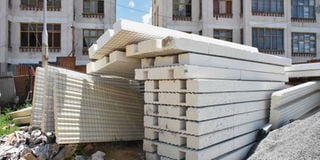Saccos have big role in creating 275 Kenyan home owners daily

A housing project being undertaken by the National Housing Corporation in Changamwe, Mombasa County, in a photo taken on April 2, 2018. PHOTO | WACHIRA MWANGI | NATION MEDIA GROUP
What you need to know:
- Housing saccos also reduce burdens by pooling resources for land purchase and provide finances for construction.
- There are 1,980 housing and investment cooperatives in Kenya with an asset base of Sh21 billion providing over 10,000 housing loans, a 10th of them mortgages.
With a membership of 14 million, saccos have a significant potential to bridge the housing gap.
Provision of affordable and decent homes is a priority for the government in achieving Vision 2030 and meeting the constitutional right to decent housing and sanitation.
If that is achieved, Kenya will have attained Sustainable Development Goal (SDG) number 10, which aims at making cities and human settlements inclusive, safe, resilient and sustainable.
A key area in the implementation of the Medium-Term Plan III, which is part of the ‘Big Four’ agenda, is a commitment to creation of 500,000 home owners in the next five years — an average of 275 everyday.
Growth of the housing market is, however, hampered by financing constraints.
MORTGAGES
First is the rising costs of housing developments, which compel potential developers to acquire debt. That negatively weighs on total financing, considering the potential delays in acquiring construction permits and other processes.
The other is access to finance. Kenya’s mortgage penetration rate is low — 3.15 per cent of gross domestic product (GDP) in 2015 — hence, the few institutions offering mortgages tend to serve high- and middle-income clients with clear credit records, sidelining the low-income bracket.
Consequently, majority of informal sector borrowers are inclined towards incremental financing and self-construction loans, which are mainly provided by cooperative societies.
Cooperatives play a crucial role in providing affordable shelter by bridging the gap in the housing finance market in Kenya. Some good examples are National Cooperative Housing Union (Nachu) and Kenya Union of Savings and Credit Cooperative Society Ltd (Kuscco), which finance long-term mortgages for individuals and societies and also offer several advantages.
INNOVATIVE
For instance, most of the savings and credit co-operative societies (saccos) offer large amounts of shorter medium-term loans for as little as 12 per cent per annum. Besides, sacco loans are typically unsecured — at least not secured with a mortgage line over a property — and are more easily accessible for up to thrice the cooperator’s savings.
Housing saccos also reduce burdens by pooling resources for land purchase and provide finances for construction. Sometimes they also act as full developers in the case of projects ranging from 10 to several hundred units.
There are 1,980 housing and investment cooperatives in Kenya with an asset base of Sh21 billion providing over 10,000 housing loans, a 10th of them mortgages. Sacco-financed housing is estimated at 90 per cent with banks providing the remainder.
With a membership of 14 million, saccos have a significant potential to bridge the housing gap.
TECHNOLOGIES
The potential of the cooperative sector is, however, inhibited by lack of innovative financing products. At present, monthly member contributions are the key source of finances but this is mainly determined by an individual’s savings habits.
Without access to longer-term sources of finance, saccos are unable to grow their loan portfolio.
Complex land administration structures; high cost of building and construction materials; inappropriate technologies; limited research on low-cost technologies; as well as stringent planning regulations and standards are other challenges saccos face. Besides, they own large tracts of land that are not adequately serviced to facilitate development of housing schemes.
The government has lowered the number of housing units entitled for a 15 per cent corporate tax relief from 400 to 100 in a bid to promote construction. Mortgage relief is expected in July. Also, a comprehensive framework is being developed to ensure investors in affordable homes get reimbursement for the cost of laying infrastructure such as roads, water and electricity.
LOW-COST
But there is a need for a special cooperative housing bond to woo diaspora saccos. The government also needs to support servicing of land by facilitating infrastructure development and linking housing saccos to information on low-cost building materials and innovative technologies.
Moreover, identification and provision of appropriate land for cooperatives housing development, especially at the county level, would greatly reduce construction costs.
There is also a need to strengthen the institutional structures of saccos as well as building capacity for housing cooperative officials to bolster accountability.
Finally, saccos should foster linkages with related international financial institutions for corporate loans and credit guarantees to expand their operations.
Ms Lukalo is a Young Professional, Kenya Institute for Public Policy Research and Analysis (Kippra). [email protected]




